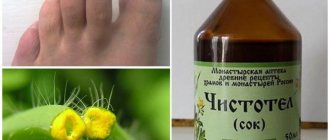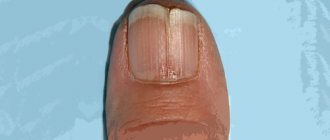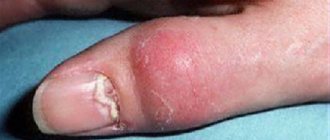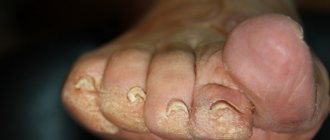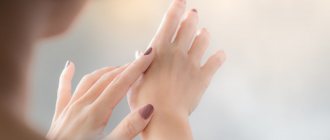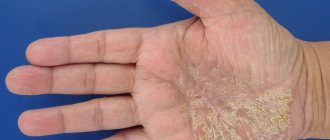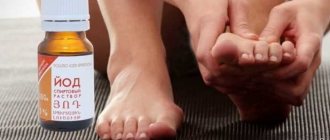Few people know about this, but a fungal infection can also affect fingernails. And from an aesthetic point of view, this problem is even more serious than foot fungus. Hands are visible to everyone, so the presence of pathology brings not only physical discomfort, but also moral discomfort. In addition, the disease is considered contagious, so treatment is carried out by dermatologists and infectious disease specialists.
Onychomycosis is the most common dermatological problem among women and men. And the older a person is, the likelihood of getting sick increases four times.
Why is onychomycosis dangerous?
When the nail plates are affected by pathogenic fungi, this poses a serious danger to the body. This is not a cold that can be cured quickly and with the help of available drugs.
During their development, fungi synthesize toxins. Accordingly, they provoke the development of dangerous somatic processes, such as:
- Inflammation and soreness of the dermis.
- The presence of blisters and toxicodermic skin lesions.
- Generalized necrosis.
- Spread of the fungus through the bloodstream to other organs and systems of the body.
- Complete destruction of the nail plate in the absence of proper treatment.
- Toxins can trigger the development of cancer.
What not to do
Inadequate treatment of onychomycosis is one of the key reasons for the spread of the fungus and purulent complications. When removing nails you should not:
- interrupt therapy at the first signs of improvement;
- try to remove the entire nail along with the growth zone;
- completely replace pharmaceutical drugs with folk remedies;
- steam your feet in hot water with obvious signs of purulent inflammation of the skin;
- treat the affected areas with warming ointments;
- independently trim the deformed edges of the plates immersed in the skin.
With the hyperkeratotic form of onychomycosis, the horny covering on the fingers is severely deformed, which leads to painful sensations. To alleviate the condition, many patients trim the corners of the free edge of the nail. But such actions in 75% of cases lead to onychocryptosis - ingrowth of the lateral edge of the plate into the nail fold.
Signs and symptoms of disease of the nail plate and the skin around it
The initial stages of nail fungus do not always begin to appear directly on the nail plate. Often the pathology manifests itself:
- excessive dryness of the skin of the hands;
- itching;
- presence of cracks;
- redness or inflammation.
Signs of fungal infection may also
- bubble formations between the fingers;
- discomfort and burning sensation in the nail plate area;
- redness of the nail fold;
- the presence of pus in the wounds between the fingers.
Important . The first symptoms are often mistaken for allergic reactions. Meanwhile, the infection spreads further and quickly affects the nails.
The nail plate changes color and turns from pink to cloudy and dull. Yellow or white spots appear along the edges or at the base, which quickly spread over the surface of the nail.
All symptoms of fungus depend on the specific type of pathogen, so before starting treatment, you need to know the form of mycosis.
Signs of mycosis on the nails appear:
- the appearance of spots, grooves and stripes on the nails;
- sharp thickening of the structure;
- color change;
- unnatural convexity or retraction of the nail plate into the bed;
- partial or complete detachment of the nail plate;
- brittleness and looseness of nails.
Removing nails at home: folk recipes
To remove toenails, products with keratolytic, alkalizing and antimycotic properties are used. They create conditions unfavorable for fungal growth.
With vinegar
Vinegar softens the stratum corneum and prevents fungal infections in the subungual space. To completely cure onychomycosis, treatment is carried out for at least a week. Removing a nail with fungus is done with the following means:
- 1 chicken egg mixed with 3 tbsp. l. vinegar;
- add 3 drops of thyme essential oil;
- leave in a dark place until the yolk is completely dissolved.
The product is applied to infected nails twice a day. The softened layers are cleaned off with a scraper.
With dimethyl phthalate
Dimethyl phthalate has fungicidal and softening properties. To remove the affected nail, you need:
- mix 1 tbsp. l. dimethyl phthalate with chicken egg;
- add 5 ml of vegetable oil;
- apply the prepared mixture to the areas affected by the fungus;
- Wrap your feet in plastic and put on warm socks.
The treatment is carried out 4-5 days before bedtime. The softened layers of the nail are cleaned with a scraper immediately after waking up.
With tar
Tar prevents the proliferation of most pathogens of onychomycosis - yeast and mold fungi, dermatophytes. Toenail removal on the big toe is carried out as follows:
- 30 minutes before bedtime, apply tar to the affected area;
- the foot is wrapped in plastic film;
- warm your feet with woolen socks;
- after waking up, the remaining tar is washed off with water;
- The softened layers are removed with scissors.
The procedure is performed until the layer with white spots is completely cleaned off.
To avoid re-propagation of fungi, antimycotic ointments are applied to the affected area for 3-7 days.
With soda
Soda baths are a painless and effective way to combat fungus. With severe symptoms of onychomycosis, the legs float daily for at least 1.5-2 weeks. To cure a nail with fungus, you should:
- dissolve 2.5 tbsp in 2 liters of boiled water. l soda;
- add 3 tbsp. l. tar soap shavings;
- immerse your feet in the solution for a quarter of an hour;
- remove the peeling parts of the plates with a scraper.
If the nail bed becomes red, you need to add sage oil to the solution or treat your nails with it after steaming.
Sources and provocateurs of infection
It would seem that all people know how important it is to adhere to the rules of hygiene and safety in public places. But until now, swimming pools and saunas are considered the most important source of fungus. Fungus on the feet can cause disease on the hands. Having a disease in your loved ones can cause problems for you too.
Important . The fungus is transmitted through towels, bed linen and indoor shoes.
Also, all the patient’s personal belongings can become a source of fungi:
- shoes;
- manicure accessories and combs;
- blankets and pillows;
- cloth.
Provokes the development of mycosis:
- humid and warm environment;
- blows and bruises;
- vascular pathologies;
- constant stress and emotional tension;
- violation of hygiene rules;
- diabetes;
- long-term use of oral contraceptives or antibiotics;
- the presence of artificial coating on the nails;
- poor nutrition;
- large amounts of sugar in the diet;
- old age.
What the disease looks like: stages and types of fungal nail diseases on the fingers with photos
Primary infection with fingernail fungus occurs almost asymptomatically . It is impossible to understand that spores have got under the nail without visible changes. And with a serious infection, symptoms appear that immediately become noticeable.
Shine
A healthy nail plate normally shines even in the absence of varnish. During polishing, the shine increases even more and is not lost upon contact with water or detergents. Lack of shine is the first sign of the presence of fungus. The surface becomes cloudy and matte.
Form
A healthy nail grows evenly, and the free edge moves down slightly.
In the presence of a fungal infection, the growth of the plates is disrupted. The nail looks crooked because one edge grows faster than the other.
Sometimes the free edge may rise up.
Surface
Healthy nails have an even and smooth surface . When furrows, depressions or bumps appear, you should think about the presence of onychomycosis.
Color
The soft pink and clear color of the nail bed quickly begins to change when athlete's foot is present. The plate becomes yellow over its entire surface. Sometimes streaks, white spots and spots may appear.
Important . The color of the spots can be green, black or brown. This indicates the presence of mold microorganisms.
The initial stage of the fungus is considered to be the moment when color changes have affected no more than 1/3 of the surface of the nail.
Classification
But before treating onychomycosis of the toenails, the form of the fungal infection should be determined.
So, the following types of onychomycosis are distinguished:
- Hypertrophic. This form occurs in the absence of long-term treatment or ineffective treatment of the problem. With this type, thickening of the nail plates and nail bed occurs, which persist for a long time even after successful treatment of hypertrophic onychomycosis of the nails. Such a lesion is typical for a severe stage and requires more serious drug treatment - tablets and antibiotics.
- Normotrophic. With this type, there is no thickening of the nail itself and the subungual area. There is fragility of the nails, and the formation of yellow-gray stripes in the nail plates. With this form, conservative and traditional local therapies are effective - ointments, varnishes, gels, etc.
- Proximal. A lesion that initially affects the base of the nail growth.
- Distal. The most common form of fungal infection. Infection begins in the area of the free edge of the plate. Initially, the nail bed is infected. Outwardly, this manifests itself in the form of a splinter embedded under the nail or a yellow spot. Wearing shoes in patients with this form causes discomfort.
- Atrophic. It manifests itself as a violation of nail growth with subsequent detachment of the plate from the nail bed. Unfortunately, this form cannot be treated with conservative treatment methods and requires surgical removal of the affected plates.
- Side. In this form, the fungus affects the lateral parts of the nail plate and the periungual ridges. Often accompanied by an ingrown toenail.
- Total onychomycosis. Signs - the entire plate is affected, it thickens, becomes dull, its color becomes yellow or even brown. As the disease progresses, the nails become deformed and take on a beak-like shape. Furrows of a dirty gray color appear, the free edge of the nail loosens.
What to do at the first signs?
If a person suspects the presence of a fungus, the first thing to do is consult a dermatologist. Diagnostic measures will play a decisive role in therapy. The doctor must determine not only the fact of infection itself, but also determine the type of pathogen. Only on the basis of these data it is necessary to select medications so that they produce a positive effect and suppress the vital activity of specific types of fungi.
The diagnostic examination consists of two stages:
- initial visual inspection;
- taking a microscopic examination and inoculating fungi into cultures.
It is the second method that makes it possible to accurately determine the type of pathogen.
How to treat an advanced condition?
If the patient ignored the initial stages of the disease and also did not follow the rules, then the disease becomes advanced. The nails become thick, lumpy and gray-yellow in color. Caring for them becomes impossible.
Important . If the matrix is damaged, the nail peels off from the skin and falls off.
The infection also spreads to the hands. Excessive dryness, peeling and cracks occur. The activity of the sweat glands increases and the patient’s hands constantly hurt and smell bad. In case of a complicated clinical picture, it makes sense to use local, folk and medicinal treatment with tablets.
Previously, in such cases, surgical methods were used to remove the nail plate affected by the fungus. But this method is painful and healing of damaged areas takes a very long time. In such cases, an excellent solution is the avulsion method. It involves the chemical “dissolution” of diseased nails with the help of special medications.
The best external remedies - ointments and varnishes
Most often, doctors prescribe the following drugs to treat mycosis:
- Lamisil ointment has a wide spectrum of action. The duration of treatment is 3 weeks.
- "Exoderil" in the form of a cream is effective in the treatment of mold and yeast fungi, as well as dermatophytes.
- "Mikonorm" in the form of a cream is a very effective remedy that promotes rapid recovery.
- "Fundosil" is a cream based on zinc and salicylic acid. Suitable for treating all types and forms of fungus.
- Nizoral must be applied several times a day. This is one of the few drugs that has no side effects.
Sometimes, in the fight against the disease, special medicinal varnishes are used, which are used in parallel with ointments and creams.
- "Batrafen" is a varnish based on ciclopirox. Treats 57 types of fungus.
- "Loceril" is an antifungal varnish against many types of fungus.
- "Fukortsin" is an antiseptic and disinfectant solution of bright pink color. Effective against all types of fungus. It is necessary to apply the drug twice a day for two weeks.
- “Demikten” is a varnish based on formic acid. You need to apply it daily until a healthy nail grows out.
All drugs with a local spectrum of action must be used according to the same scheme:
- Wash and clean the surface of the nail plate.
- Trim and file the free edge as far as possible.
- Disinfect tools after treating each nail.
- The prescribed product must be used regularly and in full accordance with the instructions or doctor's prescriptions.
Pills and medicines
Oral medications do not treat fungus alone. Therefore, their use is advisable only in combination with local remedies. The most common and effective are:
- "Ketoconazole" - the drug inhibits the development of fungi, but causes side effects: nausea, weakness.
- "Futsis" is used at any time of the day. The dosage is prescribed by the doctor and changes it throughout the course of treatment.
- Fluconazole can only be used as prescribed by a doctor. The course of treatment lasts until the healthy nail grows completely, and the dosage is prescribed by the doctor.
- Terbinafine is prescribed only to adults and children over 12 years of age.
Important . If after treatment there is no result, then it is necessary to re-take tests and undergo an examination.
Effective folk recipes
Home remedies will not work without the use of medications, but they will provide relief if necessary.
- Hydrogen peroxide is an excellent antiseptic, but the drug does not kill fungus. Good for disinfection only. Peroxide lotions should be done in addition to the main treatment.
- Propolis is suitable for preparing baths. Add 1 teaspoon of propolis tincture to warm water and hold your hand and fingers in the container for 10 minutes. Then apply propolis to your nails and put on gloves on top. The compress is left overnight.
- Tar soap gives good results in the treatment of mycosis. The affected areas must be soaped, sprinkled with salt and secured with a sterile bandage.
- the garlic in half and apply a clove to each nail. To improve treatment results, it makes sense to take garlic tincture daily before meals.
- Tea tree oil has antiseptic, antifungal and antibacterial effects. It should be applied to the nails twice a day and rubbed in a little.
- Vinegar is mixed with glycerin in equal proportions. The solution must be lubricated on the nail plates several times a day for a month.
- A 5% iodine solution works well against fungus, as it has antiseptic properties. Infected areas should be treated twice daily. During treatment, a burning sensation will occur - this is the effect of the drug. After seven days, complete regeneration of the nail plate will begin.
Each of the folk remedies helps to alleviate the condition, remove discomfort and speed up recovery.
The video presents several folk recipes for treating fungus on the hands:
Hardware treatment methods
A medical manicure using a device is carried out only if the fungus has not managed to penetrate deeply into the nail plate. The specialist removes the top layer of the affected parts of the nails with a milling cutter along with mycosis.
Should I take pills?
Fungus tablets are the most effective way to treat all types of mycosis .
However, treatment must be comprehensive and according to a specific system prescribed by the doctor. Before starting treatment, the doctor must check the condition of the patient’s kidneys and liver using tests and ultrasound diagnostics. In the initial stages of the fungus, you should not take such serious medications.
Preparing for removal
There are several ways to remove horny plates affected by the fungus. To make the procedure less painful, they undergo a preliminary preparation stage:
- Steaming. The first step is to steam your foot in a hot bath. To do this, use a chamomile decoction or a solution of laundry soap and baking soda. The procedure is performed for at least 25-30 minutes.
- Removing the top layer. The softened parts are cleaned off with nail scissors, a nail file or a scraper for better penetration of pharmaceutical products into the lesions.
- Skin protection. Most drugs for removing horny plates contain aggressive additives. Therefore, before applying them, the periungual fold is covered with an adhesive plaster.
After preparation, softening agents are applied to nails with fungus.
Prevention
To minimize the risk of contracting mycosis, you must follow some rules:
- Practice good hygiene and wash your hands frequently.
- Use your own towel and manicure accessories.
- Strengthen immunity.
- Do not use false nails or apply acrylic nails.
- Treat your nails with iodine or hydrogen peroxide.
- Dry skin thoroughly.
Compliance with all doctor’s instructions and regular use of medications will allow you to completely cure fingernail fungus within 6–12 months. Pathology is treated faster on the hands, since they are open and do not have such a humid and warm environment as the feet.
